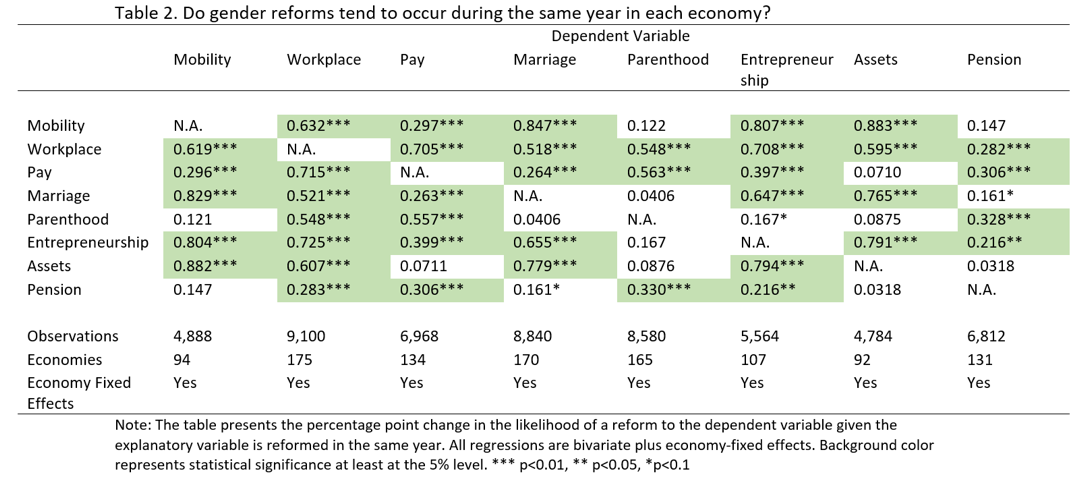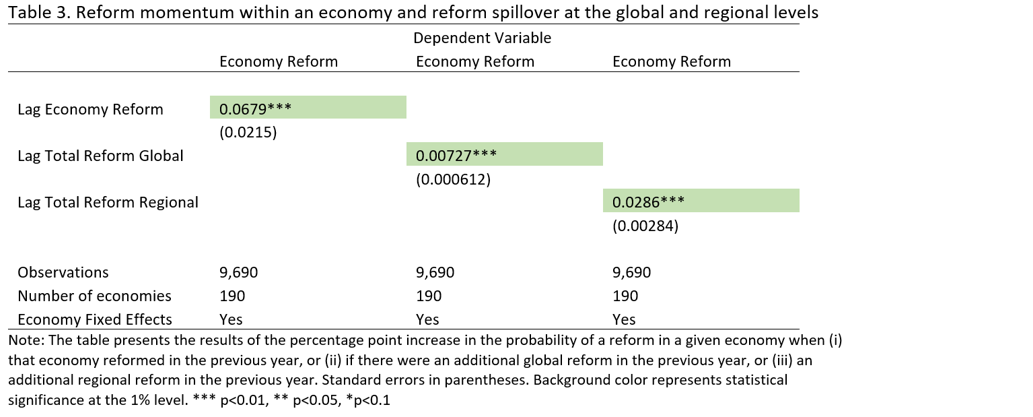 Professor Amivi Kafui Tete-Benissan teaches cell biology and biochemistry. | © Stephan Gladieu / World Bank
Professor Amivi Kafui Tete-Benissan teaches cell biology and biochemistry. | © Stephan Gladieu / World Bank
Gender inequality is one of the oldest and most pervasive forms of inequality. The latest Women, Business and the Law 2023 report unveiled a troubling reality: the pace of gender-related reforms has fallen to its slowest in two decades. Since 2021, 18 economies introduced a total 34 reforms toward gender equality, the lowest number since 2001 . Only 14 economies worldwide have achieved legal gender parity, and a staggering 2.4 billion working-aged women still do not have the same legal rights as men. The stark slowdown calls for urgent actions for policymakers to reinvigorate progress toward gender equality and gender reforms.
Comparative evidence is slowly growing on what enables and motivates gender reforms (WBL 2023, pages 62-63). The question remains on whether there exists an optimal or natural path toward legal gender equality. Is there a sequence among different reforms? Or do countries implement multiple reforms together that complement each other? Although we cannot address the question of optimality here, we can explore these questions from an empirical perspective, using the Women, Business and the Law project’s historical data set spanning 53 years, from 1970 to 2022.
Is there a natural sequence?
Some evidence seems to favor the theory of sequencing. For instance, in Europe, women’s basic economic rights may have come first, political rights were next, and equal treatment in the labor market and greater control over their own bodies ultimately followed. In Africa, the sequence differed (Doepke et al. 2012). Alternatively, family law reforms can be a precondition for women’s economic empowerment, as research shows that restraining a woman’s ability to become head of household can negatively affect women’s representation in the labor force (Gonzales et al. 2015). When women have less bargaining power at home, their capacity to pursue professional roles outside their household is constrained (Htun et al. 2019). On the other hand, labor code reforms can improve women’s status at home. Research shows that decreases in the wage gap reduce violence against women, consistent with a household bargaining model (Aizer 2010).
Using the WBL historical data, we study the sequencing of gender reforms, specifically on whether a reform in one area of the gendered law increases the chances of other gender reforms in the following year (table 1).

A notable result from table 1 is the strong relationship between reforming women’s equal rights in the Workplace and Pay indicators with reforms to Entrepreneurship in the subsequent year (column 6, rows 2-3). In addition, reforms improving a woman’s ability to start and run a business (Entrepreneurship) and receive equal remuneration (Pay) generate a ‘virtuous cycle’ of reforms that increases the likelihood of each other, year after year (column 3, row 6 and column 6, row 3). Consequently, the introduction of reforms that improve gender parity in entrepreneurship or pay legislation can expedite governments’ journeys toward women's economic empowerment .
Another notable result from table 1 is that reforms affecting women’s work during and after pregnancy (Parenthood, column 5) have the largest number of statistically significant drivers at the 1 percent level. The drivers are intuitive: legal changes that enable women to participate in the labor market (Workplace, row 2), permit women to work in higher-paying jobs that may be deemed dangerous (Pay, row 3), and improve women’s status at home (Marriage, row 4) precede greater rights for mothers.
The lack of significance in the Marriage and Asset columns (columns 4 and 7) is also noteworthy. This suggests that laws reforming a woman’s ability to marry, divorce, and inherit are not preceded by other reforms, implying that these areas require a concerted effort by the government to change since they do not naturally follow changes in other areas. On the other hand, Pension (row 8) is the only area of the law that doesn’t lead to further reforms, suggesting that it is independent of other subsequent reforms.
Do reforms happen at the same time, implying reform complementarity?
Some research argues it is almost impossible to design a detailed sequence of reforms (Funke 1993; Nsouli et al. 2005). Therefore, broad-based reforms can be the best approach toward gender equality. In countries where governments challenge customary practices and traditions, comprehensive reforms can send a clear signal and enhance the credibility of reforms (Hiemenz et al. 1991) — and gradualism can risk desertion at each point in time (Martinelli and Tommasi 1997).
Using the WBL historical data, we study the contemporaneous relationship of gender reforms; specifically, whether a reform in one area of the law increases the chances of other gender reforms in the same year (table 2).

It is noteworthy that the contemporaneous results in table 2 denote far stronger relationships than the lagged results in table 1. This shows that when countries reform a law, more than one area affecting women’s economic opportunities tends to be reformed. This occurs for labor code reforms (Workplace and Pay) and family code reforms (Assets, Mobility, and Marriage). The strongest contemporaneous relationships in table 2 are reforms between Mobility and Asset and between Mobility and Marriage, which are all governed by the family code. A reform to either area increases the probability of a reform to the other by more than 80 percentage points in the same year.
The Workplace reforms (column 2 and row 2) are implemented at the same time as all other indicators measured by WBL. Every result is significant at the 1 percent level and associated with a greater than 50 percentage point increase in the probability of a contemporaneous reform. Meanwhile, Mobility (column 1 and row 1) is in all three of the strongest relationships found (with Asset, Marriage, and Entrepreneurship).
Social insurance-related indicators, including Parenthood and Pension, tend to be reformed in isolation. For example, three-quarters of pension reforms and two-thirds of parenthood reforms happen in years where no other reforms occurred.
Reform momentum and spillover
Governments that undertake gender reforms create an environment that facilitates more reforms in their own countries and in other countries. Indeed, the WBL historical data support the existence of momentum and spillover effects (table 3). In terms of momentum, an economy that introduced a reform in one year is almost 7 percentage points more likely to reform in the next year (row 1). By introducing reforms without delay, they can set in motion a series of reforms that will benefit women and contribute to a fairer, more equal society.
A gender reform’s effect also extends beyond an economy’s national borders. Data suggest a spillover effect at both the global level (row 2) and regional level (row 3). Regional reforms are about four times more “transmissible” than global reforms — equivalent to about a 3-percentage point increase in the probability of an economy reforming for each additional regional reform in the previous year, compared to 0.7 percent at the global level.

Conclusion
“The secret of getting ahead is getting started.” – Mark Twain
Our preliminary analysis suggests that, though there is some reform sequencing, countries tend to introduce broad-based reforms on their path toward gender equality. Moreover, gender reforms exhibit a significant level of momentum within an economy and even spillover effects across economies, especially for regional neighbors. The lesson for governments is clear: enact gender reforms now and comprehensively .
We thank Daniela Behr, Marina Elefante, and Tea Trumbic for insightful comments.
Click to find out more about the Women, Business and the Law project and its historical dataset.




Join the Conversation